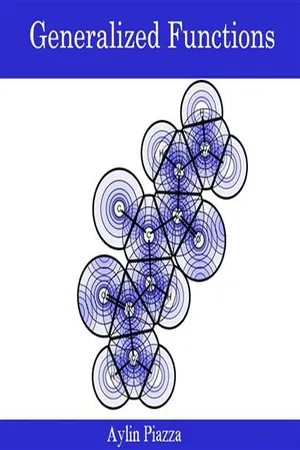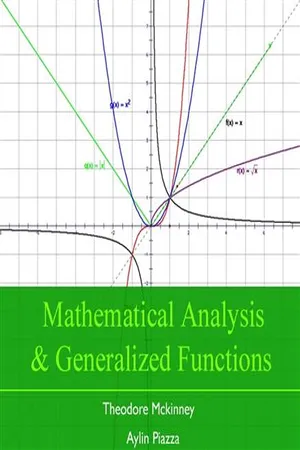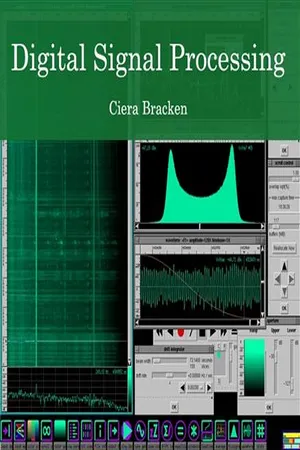Physics
3D Delta Function
The 3D delta function, also known as the three-dimensional Dirac delta function, is a mathematical concept used in physics to represent a point source of a field in three-dimensional space. It is defined as zero everywhere except at the origin, where it is infinite in such a way that its integral over all space is equal to one.
Written by Perlego with AI-assistance
Related key terms
1 of 5
8 Key excerpts on "3D Delta Function"
- eBook - PDF
- A. P. Prudnikov, K.A. Skórnik(Authors)
- 2006(Publication Date)
- Chapman and Hall/CRC(Publisher)
Chapter 3 Generalized Functions 3.1 Introduction Distributions are a generalization of locally integrable functions on the real line, or more generally, a generalization of functions that are defined on an arbitrary open set in the Euclidean space. Distributions were introduced as a result of difficulties with solving some problems of mathematical physics, quantum mechanics, electrotechnics and so forth. In these domains there are many theoretical and practical problems where the notion of function is not sufficient in this or that sense. In 1926 the English physicist Paul Dirac introduced a new element of mathematical formalism into quantum mechanics, [Dir]. He named it the Delta function and denoted it by δ ( t ). Dirac assumed that the delta function is defined on the real line and fulfills the following conditions: δ ( t ) = 0 for t = 0 , + ∞ for t = 0 , (3.1.1) and + ∞ -∞ δ ( t ) dt = 1 . (3.1.2) In the theory of real functions the two conditions (3.1.1) and (3.1.2) are contradictory. No real function exists to fulfill both conditions at the same time. On the other hand, both conditions give incorrect but highly convincing evidence of a physical intuition: δ ( t ) represents an infinitely large growth of electric tension in the infinitely short time where a unit of electricity loads. Nevertheless, the existence of mathematical models for which the search for mathematical description would lead naturally to Dirac’s deltas should not provide an excuse to use the imprecise mathematical notion that hides under δ ( t ), treat it as a function and at the same time assume that it fulfills conditions (3.1.1) and (3.1.2). Despite all formal objections many important results were achieved with the help of Dirac’s delta. In the 1930s it became obvious that Dirac’s delta has a fixed place in theoretical physics. As a result scientists sought a new mathematical theory that would help define Dirac’s - Gregory J. Gbur(Author)
- 2011(Publication Date)
- Cambridge University Press(Publisher)
(6.9). The function ρ p (r) must be an unusual object indeed, zero at every point except at the location of the charge, where it must be infinite. A safe physical answer to this difficulty would be to state that there is no such thing as a true point charge, as every charge presumably has a finite size, and hence finite density, associated with it. Mathematically, however, point charges are extremely convenient entities, and we would like to avoid doing away with them if at all possible. The resolution of this problem is to represent the charge density of a point charge located at r 0 by a special mathematical entity known as a three-dimensional Dirac delta function, ρ p (r) = qδ (3) (r − r 0 ). (6.13) 6.2 Introduction to delta functions 181 A delta function is an example of a distribution, a generalization of the ordinary functions we are used to working with. It is to be noted that the function δ (3) must have dimensions of [length] −3 , since the charge density has dimensions of [charge]/[length] 3 . To produce agreement between the continuous and discrete forms of Gauss’ law, Eqs. (6.9) and (6.3), we require the distribution δ (3) (r − r 0 ) to satisfy the following property: V δ (3) (r − r 0 )d 3 r = 0, r 0 ∈ V , 1, r 0 ∈ V . (6.14) In fact, an integral identity of this form is the only way we can define the delta function, as its behavior falls outside the bounds of what is acceptable according to the normal theory of functions. In spite of its strangeness, the delta function is an extremely useful mathematical tool which will continue to make an appearance throughout the rest of this book. This distribution, and others like it, form the subject of this chapter. 6.2 Introduction to delta functions We restrict ourselves for the moment to functions of one variable x. We introduce a Dirac delta function δ(x) as a mathematical object which satisfies the following pair of properties. 1. It must vanish away from the origin: δ(x) = 0, x = 0.- No longer available |Learn more
- (Author)
- 2014(Publication Date)
- White Word Publications(Publisher)
In applied mathematics, the delta function is often manipulated as a kind of limit (a weak limit) of a sequence of functions, each member of which has a tall spike at the origin: for example, a sequence of Gaussian distributions centered at the origin with variance tending to zero. An infinitesimal formula for an infinitely tall, unit impulse delta function (infinitesimal version of Cauchy distribution) explicitly appears in an 1827 text of Augustin Louis Cauchy. Siméon Denis Poisson considered the issue in connection with the study of wave propagation as did Gustav Kirchhoff somewhat later. Kirchhoff and Hermann von Helmholtz also introduced the unit impulse as a limit of Gaussians, which also corresponded to Lord Kelvin's notion of a point heat source. At the end of the 19th century, Oliver Heaviside used formal Fourier series to manipulate the unit impulse. The Dirac delta function as such was introduced as a convenient notation by Paul Dirac in his influential 1927 book Principles of Quantum Mechanics . He called it the delta function since he used it as a continuous analogue of the discrete Kronecker delta. Definitions The Dirac delta can be loosely thought of as a function on the real line which is zero everywhere except at the origin, where it is infinite, and which is also constrained to satisfy the identity ________________________ WORLD TECHNOLOGIES ________________________ This is merely a heuristic definition. The Dirac delta is not a true function, as no function has the above properties. Moreover there exist descriptions of the delta function which differ from the above conceptualization. For example, sinc( x / a )/ a (where sinc is the sinc function) becomes the delta function in the limit as a → 0, yet this function does not approach zero for values of x outside the origin, rather it oscillates between 1/ x and −1/ x more and more rapidly as a approaches zero. - No longer available |Learn more
- (Author)
- 2014(Publication Date)
- Library Press(Publisher)
For example, the probability density function of a discrete distribution consisting of points , with corresponding probabilities , can be written as As another example, consider a distribution which 6/10 of the time returns a standard normal distribution, and 4/10 of the time returns exactly the value 3.5 (i.e. a partly continuous, partly discrete mixture distribution). The density function of this distribution can be written as The delta function is also used in a completely different way to represent the local time of a diffusion process (like Brownian motion). The local time of a stochastic process B ( t ) is given by and represents the amount of time that the process spends at the point x in the range of the process. More precisely, in one dimension this integral can be written where is the indicator function of the interval [ x − ε , x + ε ]. ________________________ WORLD TECHNOLOGIES ________________________ Application to quantum mechanics We give an example of how the delta function is expedient in quantum mechanics. The wave function of a particle gives the probability amplitude of finding a particle within a given region of space. Wave functions are assumed to be elements of the Hilbert space L 2 of square-integrable functions, and the total probability of finding a particle within a given interval is the integral of the magnitude of the wave function squared over the interval. A set { φ n } of wave functions is orthonormal if they are normalized by where δ here refers to the Kronecker delta. A set of orthonormal wave functions is complete in the space of square-integrable functions if any wave function ψ can be expressed as a combination of the φ n : with . Complete orthonormal systems of wave functions appear naturally as the eigenfunctions of the Hamiltonian (of a bound system) in quantum mechanics that measures the energy levels, which are called the eigenvalues. The set of eigenvalues, in this case, is known as the spectrum of the Hamiltonian. - eBook - PDF
- Roderick Wong(Author)
- 2010(Publication Date)
- WSPC(Publisher)
Chapter 6 DISTRIBUTION THEORY 6 . 1 . THE DIRAC DELTA FUNCTION In many books on applied mathematics and mathematical physics, one will encounter the function δ ( x ) defined by the equations δ ( x − a ) = 0 , x = a, (6 . 1 . 1) and ∞ −∞ φ ( x ) δ ( x − a ) dx = φ ( a ) , a ∈ R , (6 . 1 . 2) for any continuous function φ ( x ) on R ; see, e.g., [2, p.83], [4, p.152], [5, p.183] and [13, p.288]. However, mathematically, these two equations are inconsistent in the classical sense of a function and an integral, since the value of the integral of a function which is zero everywhere except for a fi-nite number of points should be zero. The function given in (6 . 1 . 1) − (6 . 1 . 2) is known as the Dirac delta function , and it was introduced by Dirac in his theory of quantum mechanics. There are now two mathematically mean-ingful approaches to help interpret the delta function δ ( x ). One approach is to use Functional Analysis, and to consider δ a := δ ( x − a ) as a continuous linear functional acting on a space of smooth functions; the action of δ a on a particular function φ ( x ) is given by the value φ ( a ). This approach led to the Schwartz’s theory of distributions; see [15, p.141] and [18, p.77]. The other approach is to find a sequence of functions δ n ( x − a ) such that lim n →∞ ∞ −∞ δ n ( x − a ) φ ( x ) dx = φ ( a ) , a ∈ R . (6 . 1 . 3) This approach was introduced by Temple [21], and followed by Lighthill [13] and Jones [9]. The sequence δ n ( x ) satisfying (6.1.3) is called a delta sequence , and we write, symbolically, lim n →∞ δ n ( x − a ) = δ ( x − a ) , x ∈ R . (6 . 1 . 4) 247 248 LECTURE NOTES ON APPLIED ANALYSIS It seems that the second approach is more acceptable to physicists and applied mathematicians. But it was the first approach that has made a greater impact in analysis, and especially in the theory of partial differential equations; see, e.g., [8] and [20]. - No longer available |Learn more
- (Author)
- 2014(Publication Date)
- Research World(Publisher)
For example, the probability density function of a discrete distribution consisting of points , with corresponding probabilities , can be written as As another example, consider a distribution which 6/10 of the time returns a standard normal distribution, and 4/10 of the time returns exactly the value 3.5 (i.e. a partly continuous, partly discrete mixture distribution). The density function of this distribution can be written as The delta function is also used in a completely different way to represent the local time of a diffusion process (like Brownian motion). The local time of a stochastic process B ( t ) is given by and represents the amount of time that the process spends at the point x in the range of the process. More precisely, in one dimension this integral can be written where is the indicator function of the interval [ x − ε , x + ε ]. ____________________ WORLD TECHNOLOGIES ____________________ Application to quantum mechanics We give an example of how the delta function is expedient in quantum mechanics. The wave function of a particle gives the probability amplitude of finding a particle within a given region of space. Wave functions are assumed to be elements of the Hilbert space L 2 of square-integrable functions, and the total probability of finding a particle within a given interval is the integral of the magnitude of the wave function squared over the interval. A set { φ n } of wave functions is orthonormal if they are normalized by where δ here refers to the Kronecker delta. A set of orthonormal wave functions is complete in the space of square-integrable functions if any wave function ψ can be expressed as a combination of the φ n : with . Complete orthonormal systems of wave functions appear naturally as the eigenfunctions of the Hamiltonian (of a bound system) in quantum mechanics that measures the energy levels, which are called the eigenvalues. The set of eigenvalues, in this case, is known as the spectrum of the Hamiltonian. - eBook - PDF
Partial Differential Equations
A First Course
- Rustum Choksi(Author)
- 2022(Publication Date)
- American Mathematical Society(Publisher)
Well, nothing could be further from the truth; the delta “function” comes up naturally, even when one just deals with functions. As we shall see, it plays a central role in two fundamental areas: • linear second-order partial differential equations, • Fourier analysis (Fourier series and the Fourier transform). Indeed, we stress that it is one of the most important “ players ” in this book. To give a small hint of this, we present in the next subsection two simple examples involv-ing honest-to-goodness functions where this, as yet ill-defined, delta “function” arises. These examples will help provide the intuition behind both the essential character of the delta “function” and its eventual definition as a distribution. The key phenomenon prevalent in both examples is concentration . 5.2.1. • The Delta “Function” and the Derivative of the Heaviside Func-tion. Consider the Heaviside 4 function defined by ?(?) ≔ { 0, ? < 0, 1, ? ≥ 0. (5.5) What is its derivative? If we look pointwise , i.e., fix a point ? and ask what ? ′ (?) is, we see that ? ′ (?) = { 0, ? ≠ 0, ?????𝑖???, ? = 0. Can we ignore the fact that ? ′ (0) is undefined? Since ? ′ (?) = 0 except at one point, our previous discussion about values at a single point might suggest that the derivative ? ′ behaves like the zero function. But then ?(?) should be a constant, which is not the case: ?(?) changes from 0 to 1 but does so instantaneously . Hence perhaps we should assert that the derivative is entirely concentrated at ? = 0 and define ? ′ (0) to be +∞ , associated with the instantaneous change from 0 up to 1 at ? = 0 . In other words, take ? ′ (?) = { 0, ? ≠ 0, +∞, ? = 0. (5.6) Unfortunately there is ambiguity in this +∞ ; for example, in order to reconstruct ? (up to a constant) from its derivative we would need to make sense of the recurring product “ 0 × +∞ ”. - eBook - PDF
Green's Functions and Linear Differential Equations
Theory, Applications, and Computation
- Prem K. Kythe(Author)
- 2011(Publication Date)
- Chapman and Hall/CRC(Publisher)
2 The Concept of Green’s Functions Green’s function for a differential equation is its solution when the forcing term is the Dirac delta function due to a unit point source (or sink) in a given domain. This solution provides us with a method to generate solutions of linear ordinary and partial differential equations subject to different kinds of boundary conditions and internal sources. This method is important in a variety of physical problems and applications, and has a special role in the study of certain problems of mathematical physics. 2.1. Generalized Functions The construction of Green’s functions for different types of boundary value problems is an important subject in itself since these functions are used in a wide range of applications. Before developing the subject of Green’s functions we must have a clear understanding of the mathematical behavior of generalized functions. To this end we will first study certain elementary aspects of generalized functions, followed by the concept of Green’s function. A point source is represented by the Dirac delta function, which belongs to a class of functions known as generalized functions (or distributions , as they are often called, although care must be taken to distinguish them from ordinary distributions). The existence of distributions in the generalized sense is based on relations which are not functions in the traditional sense. The physical examples we want to consider are related to the determination of the intensity of a concentrated force F acting at time t = 0 or at the origin x = 0 of a rectangular cartesian coordinate system. Example 2.1. Consider the vibrating system of a spring, and suppose that an external force F ( t ) is applied to the interval − t 0 ≤ t ≤ t 0 , such that F ( t ) = 0 , t 0 < | t | , f ( t ) , t 0 ≥ | t | , (2.1) 18
Index pages curate the most relevant extracts from our library of academic textbooks. They’ve been created using an in-house natural language model (NLM), each adding context and meaning to key research topics.







